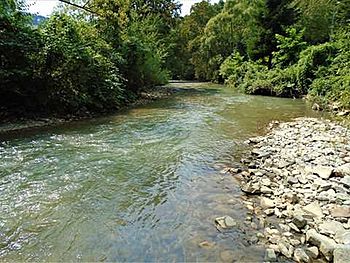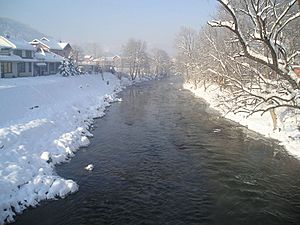Vrbanja (river) facts for kids
Quick facts for kids Vrbanja |
|
|---|---|

The Vrbanja in Šiprage in summertime
|
|
| Country | Bosnia and Herzegovina |
| Physical characteristics | |
| Main source | Vlašić 1,520 m (4,990 ft) |
| River mouth | Vrbas 164 m (538 ft) 44°46′44″N 17°13′12″E / 44.77889°N 17.22000°E |
| Length | 70.5 km (43.8 mi) |
| Basin features | |
| Progression | Vrbas→ Sava→ Danube→ Black Sea |

The Vrbanja (Serbian Cyrillic: Врбања) is a river in Bosnia and Herzegovina. It is one of the biggest rivers that flows into the Vrbas river. The Vrbanja river basin covers an area of about 703.5 square kilometers. This river is important for making electricity. The Vrbanja is about 70.5 kilometers long, but some people think it might be longer, up to 95.4 kilometers.
Contents
What Does the Name Vrbanja Mean?
The name Vrbanja comes from the word for "willow trees." Many willow trees grow along the riverbanks, from a place called Kruševo Brdo all the way to Banja Luka. You can find other places named after willows too, like the village of Vrbanjci and a part of Banja Luka called Vrbanja. Even the Vrbas river and a bridge in Sarajevo share this willow connection.
Where Does the Vrbanja River Flow?
The Vrbanja river starts high up on the Vlašić Mountain. Its source is near a village called Pilipovina, about 1,530 meters above sea level. The area where it begins is known as "Prelivode." This spot is between the Vlašić mountain (1933 m) and Meokrnje mountain (1425 m).
The Vrbanja river flows through many towns and villages. These include Kruševo Brdo, Šiprage, Obodnik, Vrbanjci, Kotor Varoš, Zabrđe, and Čelinac. Finally, it reaches the settlement of Vrbanja before joining the Vrbas river in Banja Luka.
How Was the Vrbanja Valley Used in the Past?
Between 1878 and 1914, when the Austro-Hungarian Empire ruled, a large railway system was built along the Vrbanja river. This railway helped to move natural resources, especially wood and minerals. The train tracks followed the Vrbanja valley from Kotor Varoš to Šiprage. From there, smaller tracks branched off along the river's smaller streams.
What Rivers Flow into the Vrbanja?
Many smaller rivers and streams join the Vrbanja. These come from the Vlašić, Čemernica, Borja, and Uzlomac mountains.
The most important rivers that join from the right side are:
The most important rivers that join from the left side are:
Images for kids
-
Vbanja river at Tuleška bridge locality, near Šiprage
-
Vrbanja river in Kruševo Brdo
See Also
 In Spanish: Río Vrbanja para niños
In Spanish: Río Vrbanja para niños



